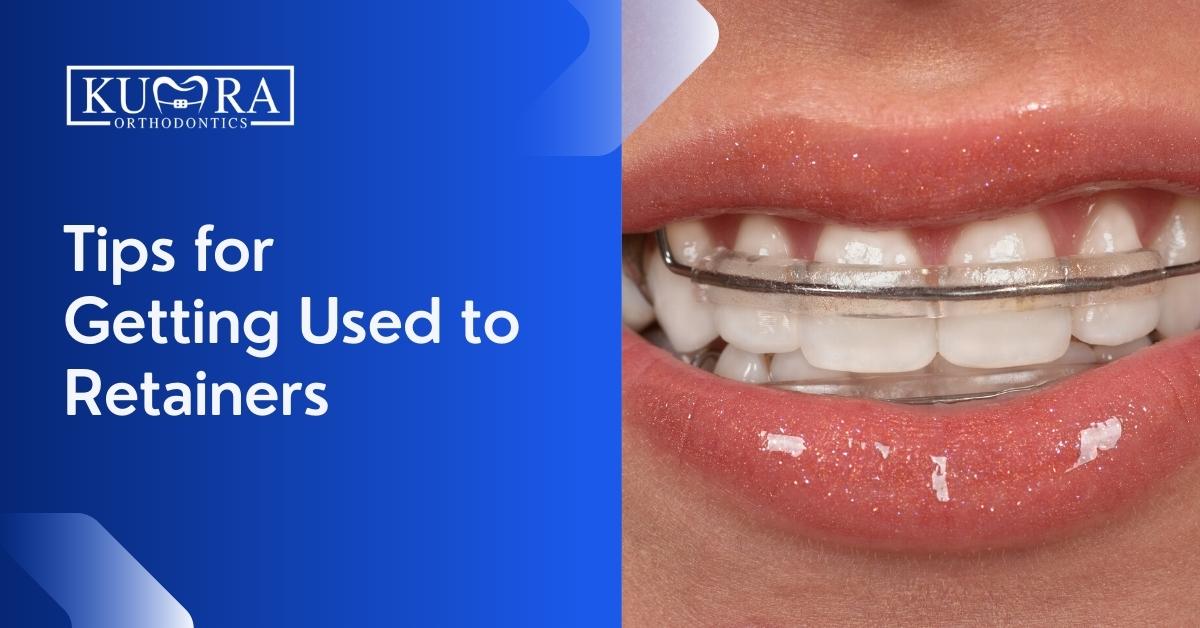Adjusting to life with dental retainers can sometimes feel like a challenge. Whether you’re just starting your orthodontic journey or transitioning from braces, getting comfortable with retainers might take some time and patience. But don’t worry, we’ve got you covered.
Retainers play a crucial role in your orthodontic treatment. They help keep your teeth in their new position after the braces come off, ensuring that your smile stays perfect. However, it’s normal to find the sensation of having a foreign object in your mouth a bit strange at first. You might also face some challenges while speaking and eating. But rest assured, these issues are temporary and can be managed with our expert tips.
In the next sections, we’ll share practical tips to help you adjust to your retainers. We will cover everything from improving comfort, maintaining oral hygiene, to tackling common problems like speech issues caused by retainers. With a little patience and following our advice, you’ll soon find that your retainers have become a natural part of your daily routine.
Understanding How Retainers Work
Retainers serve as an essential component of your orthodontic journey. Tailored to fit your mouth, these devices are designed to hold your teeth in their newly aligned positions once braces are removed.
They prevent your teeth from reverting to their original alignment, thereby securing the results of your orthodontic treatment. The reason retainers are so crucial is that the gums and bone surrounding your teeth require more time to adapt to the new alignment than the teeth themselves. By wearing a retainer, you give these supporting structures the necessary time to stabilize around the new positions of your teeth.
How to Wear a Retainer
The effectiveness of a retainer hinges on correct usage. Your orthodontist will guide you with specific instructions that cater to your individual needs. As a general rule, you should keep your retainer in your mouth at all times, except during meals and dental hygiene activities such as brushing or flossing.
It’s vital to clean your retainer regularly to prevent bacteria and plaque from accumulating. When your retainer is not in use, store it safely in its case to avoid potential damage or loss. Consistency in wearing your retainer plays a pivotal role in preserving the alignment of your new smile.
Is it Normal for Retainers to Hurt?
It’s not uncommon to feel some discomfort or pressure when you first start wearing a retainer. Your mouth needs time to adjust to the presence of the new device. However, any discomfort you experience should gradually decrease after a few days as your mouth becomes accustomed to the retainer.
If you continue to experience pain or if you notice any sores or cuts in your mouth, it’s important to reach out to your orthodontist. They can make necessary adjustments to the fit of your retainer to increase its comfort.
A crucial point to remember is that while retainers might induce temporary discomfort, they should never cause prolonged or severe pain.
Read More: How Do Retainers Work
Tips for Getting Used to Retainers
Adjusting to life with retainers can be a bit difficult. However, with some helpful tips and a little patience, you’ll soon find that your retainer becomes a natural part of your daily routine. Here are five practical tips to help you get used to your new retainer:
Practice Makes Perfect – Especially When Speaking
When you first start using a retainer, you might detect a slight change in your speech or even a lisp. This is completely normal and nothing to worry about! To help your mouth adjust to this new accessory, practice speaking with your retainer. Reading aloud from a book or engaging in frequent conversations can be an excellent way to help you speak clearly and confidently with your retainer.
Consistency is Key
Consistent usage is instrumental in acclimating to your retainer. The more frequently you wear it, the quicker your mouth will adapt to its presence. Aim to have your retainer on at all times, except when indulging in meals or performing oral hygiene activities such as brushing and flossing your teeth.
Maintain Stellar Oral Hygiene
Ensuring good oral hygiene is of paramount importance when you’re wearing a retainer. Regularly brush your teeth and clean your retainer every day to prevent any plaque build-up. It not only keeps your retainer in top shape but also promotes overall oral health.
Don’t Skip Those Regular Check-ups
Regular visits to your orthodontist play a crucial role in your retainer journey. These check-ups allow your orthodontist to assess the fit of your retainer and make any necessary adjustments to ensure it’s comfortable and working optimally.
Patience is Your Best Friend
Lastly, it’s essential to remember that patience is truly a virtue when adjusting to a new retainer. It might take some time, but with consistent usage and diligent oral hygiene, you’ll find yourself comfortably adjusted to your retainer before you know it!
Needing an orthodontic appointment?
Visit Kumra Orthodontics Washington, DC or Kumra Orthodontics Stafford, VA, and request an appointment with us!
How to Make Retainers Hurt Less
While it’s true that retainers can cause an initial bout of discomfort, there are several strategies to minimize this discomfort and make the adjustment period significantly more manageable. Here are five effective tips to help alleviate any discomfort associated with your retainer:
Seek Help from Over-the-Counter Pain Relievers
Over-the-counter pain relievers can be a big help in managing the initial discomfort you may experience when you first start wearing your retainer. Remember always to follow the dosage instructions provided on the package.
Try a Cold Compress
A simple yet effective method of pain relief is applying a cold compress to the outside of your mouth. It can help alleviate any pain or swelling associated with your retainer, providing immediate relief.
The Wonders of Saltwater Rinses
Rinsing your mouth with warm salt water can soothe any sore spots in your mouth caused by your retainer. A tried and tested home remedy works wonders, but remember not to swallow the salt water.
Embrace a Soft Diet
Incorporating soft foods into your diet can help reduce the discomfort during the first few days of wearing a new retainer. Hard or crunchy foods could potentially cause additional discomfort, so it’s best to avoid them until you’re more accustomed to your retainer.
Regular Adjustments are Beneficial
Regular adjustments with your orthodontist can ensure your retainer fits correctly and comfortably. If your retainer continues to cause pain or discomfort, don’t hesitate to schedule an appointment with your orthodontist. They can make necessary adjustments, ensuring your comfort and the effectiveness of your treatment.
How Long Does it Take to Get Used to Retainers?
Retainers are more than just the final stage of your orthodontic treatment; they offer a multitude of benefits that help maintain your smile and contribute to overall oral health. Here are some significant benefits of getting a retainer:
- Keeps Your Teeth in Line: Retainers are custom-made to hold your teeth in their new positions after braces. They prevent your teeth from shifting back to their original positions, ensuring the longevity of your orthodontic treatment results.
- Defends Against Tongue Thrust: Some retainers can help correct speech impediments caused by tongue thrust, which occurs when the tongue pushes against the teeth during speech.
- Helps You Avoid Clenching: Retainers can provide a solution for individuals who tend to clench their teeth, offering a layer of protection1.
- Promotes Better Oral Hygiene: Retainers encourage better oral hygiene long after its use goes away.
- Aids in TMJ Alignment: Certain retainers can also assist with keeping the jaw in line and reducing discomfort associated with Temporomandibular Joint Disorder (TMJ).
The benefits of wearing retainers after braces are substantial. They serve as an insurance policy for your newly aligned teeth, securing the investment of time and money you’ve made in your orthodontic treatment. So remember, wearing your retainer is not just about preserving your perfect smile—it’s also about ensuring the health and functionality of your teeth in the long run.
Retainers FAQs
Can you drink with retainers?
Yes, you can drink while wearing your retainer. However, it’s best to avoid hot drinks as they may warp the retainer’s plastic. Also, keep in mind that drinking beverages with high sugar content can lead to plaque buildup around the retainer. Therefore, it’s crucial to clean the retainer after consuming such drinks.
Why are retainers so uncomfortable?
Retainers may feel uncomfortable initially because they’re designed to hold your teeth in their new position. This discomfort is usually temporary and should lessen over time as your mouth adjusts. If you continue to experience discomfort after a few weeks, contact your orthodontist for a possible adjustment.
How do you eat with retainers?
It’s recommended to remove your retainer while eating. This prevents food particles from getting trapped in the retainer, which could lead to plaque buildup and potential damage to the retainer. After eating, remember to clean your teeth before putting the retainer back in.
Start Your Journey to a Perfect Smile with Kumra Orthodontics Today!
At Kumra Orthodontics, your leading orthodontist in Washington, DC, we are committed to making your journey to a perfect smile as comfortable and efficient as possible. We understand that adapting to a retainer can be challenging. However, with the expert guidance of our experienced team and your commitment, you can effortlessly navigate this crucial phase of your orthodontic treatment.
Retainers play a vital role in maintaining the alignment of your teeth after braces. While the initial adjustment period might bring some discomfort, rest assured that it’s temporary. Our team will provide you with all the necessary tips and advice to help ease this transition.
Ready to take the next step? Contact us today. Your journey towards a perfect smile awaits!



